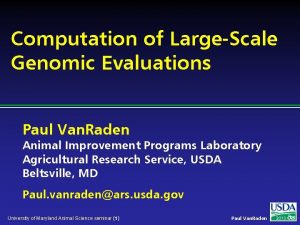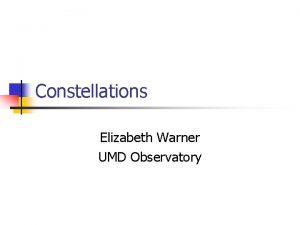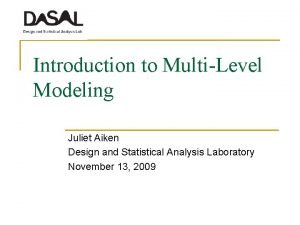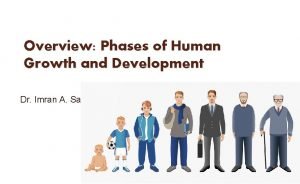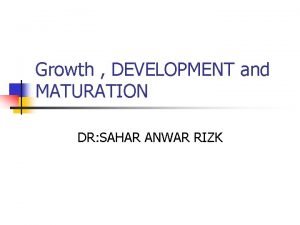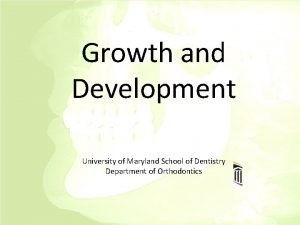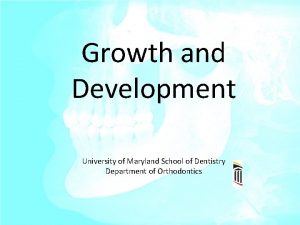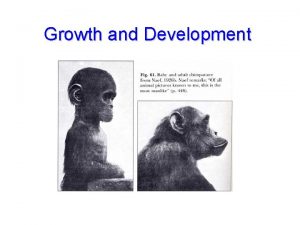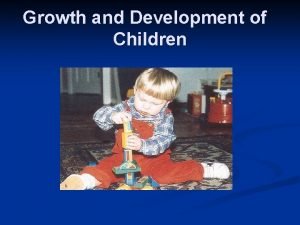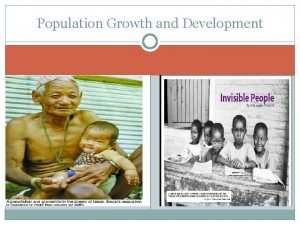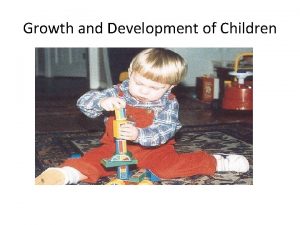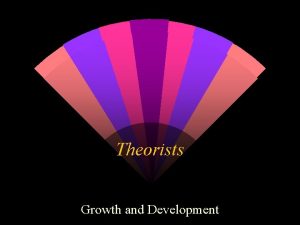Growth and Development University of Maryland School of
































- Slides: 32

Growth and Development University of Maryland School of Dentistry Department of Orthodontics

UNIT C 2 Assessment of Skeletal and Other Developmental Ages

Overview • Clinical Assessment of Growth and Development – Hand wrist x-ray – Cervical Vertebral Maturation – Behavioral Development

• Dental development correlates reasonably well with chronologic age but occurs relatively independently. Of all the indicators of developmental age, dental age correlates least well with the other developmental indices • Physical growth status also varies from chronologic age with many children but does correlate well with skeletal age, which is determined by the relative level of maturation of the skeletal system • In planning orthodontic treatment it can be important to know how much skeletal growth remains • An assessment of skeletal age must be based on the maturational status of markers with the skeletal system.

Dental Age vs. Chronologic Age 7 years old

Dental Age vs. Chronologic Age 11 years old

Dental Age vs. Chronologic Age 17 years old

• Dental development correlates reasonably well with chronologic age but occurs relatively independently. Of all the indicators of developmental age, dental age correlates least well with the other developmental indices • Physical growth status also varies from chronologic age with many children but does correlate well with skeletal age, which is determined by the relative level of maturation of the skeletal system • In planning orthodontic treatment it can be important to know how much skeletal growth remains • An assessment of skeletal age must be based on the maturational status of markers with the skeletal system.

Hand Wrist x-ray • For many years the standard for skeletal development was assessing ossifications of the bones of the hand wrist • A radiograph of the hand wrist provides a view so some 30 small bones have predictable sequence of ossification • Hand-wrist radiograph of the patient is compared with standard radiographic images in an atlas of the development of the hand wrist (Tanner JM. Assessment of Skeletal Maturity and Prediction of Adult Height. New York: WB Saunder; 2001

Hand-wrist skeletal maturation forefin ger index middle finger digitus medius ring finger digitus anularis little finger digitus minimus poll ex

• Two general approaches to assessment of hand-wrist radiograph: • Comparison methods of Greulich and Pyle and Tanner Whitehouse • Greulich and Pyle: use atlas as standard of comparison • Consists of plates of “typical” hand-wrist radiographs at 6 -month intervals of chronological age • Each bone is compared and assigned an ages are averaged to find “mean age” of individual • Tanner Whitehouse: compares individual with radiographic standards of skeletal maturity of “normal” children of similar age and sex • Individual bones are rated using biological weighted scoring system to assign “skeletal age”

• Specific indicators to relate skeletal maturation to pubertal growth curve • Focuses on the maturation evaluation of the individual rather than on mean values • Fishman developed a system for assessment of skeletal maturation on basis of 11 discrete “skeletal maturity indicators” covering entire period of adolescent development • Provides graphs and tables to estimate individual’s relative growth rate and percentage of total adolescent growth completed

Skeletal Maturity Indicators SMI Epiphyseal Widening 1 2 3 Third finger – proximal phalanx Third finger – middle phalanx Fifth finger – middle phalanx Ossification 4 Adductor sesamoid of thumb Capping 5 6 7 Third finger – distal phalanx Third finger – middle phalanx Fifth finger – middle phalanx Fusion 8 9 10 11 Third finger – distal phalanx Third finger – proximal phalanx Third finger – middle phalanx Radius

Growth velocity curve The approximate timing of these childhood and adolescent stages of maturation as related to an average developmental growth curve. Although small preadolescent growth spurts can occasionally occur, the late childhood period is usually one of relatively slow growth. High Velocity Accelerating Velocity Decelerating Velocity

Skeletal maturation as determined by hand -wrist x-rays • Burlington Growth Center • Peak mandibular circumpubertal growth was more closely related to Greulich-Pyle or Tanner. Whitehouse skeletal age than chronological age • Ossification of sesamoid preceded peak mandibular growth by 1. 1 years in girls and 0. 7 years in boys (Pileski et al 1973) • Brush-Bolton Growth Study • Tofani (1972) reported that distal phalange fusion was good predictor of maximum mandibular growth

Cervical Vertebral Maturation • Recently, a similar assessment of skeletal age based on the cervical vertebrae, as seen in cephalometric radiograph, has been developed. (Baccetti T, Franchi L, Mc. Namara JA Jr. The cervical vertebral maturation (CVM) method for the assessment of optimal treatment timing in dentofacial orthopedics. Sem Orthod 11: 119 -129, 2005) • Since cephalometric radiographs are obtained routinely for orthodontic patients, this method has the advantage that a separate radiograph is not needed, and the assessment of skeletal age from vertebral development seems to be as accurate as with hand-wrist radiographs • The best way to determine the cessation of growth is serial cephalometric radiographs*

Cervical Vertebrae (C 1 -C 7)

C 1 (Atlas), C 2 (Axis), C 3, C 4 C 1 (Atlas) – responsible for “yes” motion of the head C 2 (Axis) – responsible for rotation or “no” motion of the head

2 3 4 Cephalometric Xray

Cervical Vertebrae 2 3 4 • Three primary ossification centers develop in each cartilaginous vertebra, one in the body and one in each half of the vertebral arch. At birth, each typical vertebra consists of three bony parts, united by hyaline cartilage • Typical vertebrae begin to ossify toward the end of the embryonic period (7 to 8 weeks) • The halves of the vertebral arch begin to fuse in the cervical region during the first year • Fusion of the body with the vertebral arches occurs during childhood (5 to 8 years) • During puberty, five secondary ossification centers develop • Evaluate the cervical maturation by changes in the concavity of the lower border, height, and shape of the vertebral body**

Growth prediction from cervical vertebrae

* * * *CVMS 1, 2 & 3 Are the best times for growth modification *CVMS 2 & 3 usually corresponds with the beginning of the pubertal growth spurt

CVMS Examples

CVMS 2

CVMS 1

CVMS 3

CVMS 3 -4

CVMS 5

• The use of the CVM method enables the clinician to identify optimal timing for the treatment of a series of dentoskeletal disharmonies in all three planes of space • The concern for optimal timing for dentofacial orthopedics is linked closely to the identification of periods of accelerated growth that can contribute significantly to the correction of skeletal imbalances in the individual patient

Behavioral Development • Physical growth can be viewed as the outcome on an interaction between genetically controlled cell proliferation and environmental influences that modify the genetic program • Similarly, behavior can be considered the result of an interaction between innate or instinctual behavioral patterns and behaviors learned after birth • In humans the great majority of behavior is learned • For this reason it is less easy to construct stages of behavioral development in humans than stages of physical development

Stages of Emotional and Cognitive Development 1. 2. Emotional Development – – – – Development of basic trust (birth to 18 months) Development of Autonomy (18 months to 3 years) Development of Initiative (3 to 6 years) Mastery of Skill (Age 7 to 11 years) Development of Personal Identity (Age 12 to 17 years) Development of Intimacy (Young Adult) Guidance of the next generation (Adult) Attainment of Integrity (Late Adult) Cognitive Development – – Sensorimotor Period (first 2 years of life) Preoperational Period ( 2 to 7 years) Period of Concrete Operation (7 to 11 years) Period of Formal Operation (11 to Adult)

Summary • The correlation between developmental ages of all types and chronologic age is quite good, as biologic correlations go • For most developmental indicators, the correlation coefficient between developmental status and chronologic age is about 0. 8 • The correlation of dental age with chronologic age is not quite as good, about 0. 7, which means that there is about a 50% chance of predicting the stage of dental development from the chronologic age • What will actually occur in any one individual is subject to the almost infinite variety of human variation, and the magnitude of the correlation coefficients must be kept in mind
 詹景裕
詹景裕 University of maryland observatory
University of maryland observatory Umd capital region health
Umd capital region health University of maryland hci
University of maryland hci Environmental engineering
Environmental engineering University of maryland
University of maryland University of maryland observatory
University of maryland observatory Inside loyola webadvisor
Inside loyola webadvisor Juliet aiken
Juliet aiken Medscope university of maryland
Medscope university of maryland What is plant growth analysis
What is plant growth analysis Pith
Pith Primary growth and secondary growth in plants
Primary growth and secondary growth in plants Primary growth and secondary growth in plants
Primary growth and secondary growth in plants Growthchain
Growthchain Geometric growth population
Geometric growth population Neoclassical growth theory vs. endogenous growth theory
Neoclassical growth theory vs. endogenous growth theory Difference between organic and inorganic growth
Difference between organic and inorganic growth Social changes in adulthood
Social changes in adulthood Theory of growth and development
Theory of growth and development Stages of human development
Stages of human development Emotional changes in childhood
Emotional changes in childhood Pretest growth development and sexuality
Pretest growth development and sexuality Sahar anwar
Sahar anwar Levels of growth and development
Levels of growth and development Stages of growth and development from infancy to adulthood
Stages of growth and development from infancy to adulthood Economic development vs economic growth
Economic development vs economic growth Personal growth and professional development.
Personal growth and professional development. Growth and development pictures
Growth and development pictures Middle childhood growth and development
Middle childhood growth and development Distinguish between growth and development
Distinguish between growth and development Growth and development in physical education
Growth and development in physical education Rice plant stages
Rice plant stages





